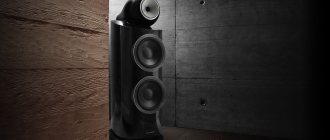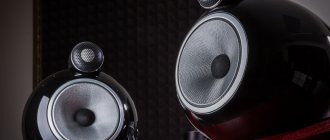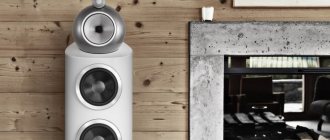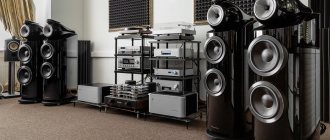A brand is of great importance in the modern world. For example, a considerable number of people would prefer to significantly overpay, but purchase a piece of clothing with the coveted label somewhere on the pocket or sleeve. And not least because it will increase their status in certain circles. The same is true when buying a car, but in this case the brand often guarantees something more significant than the attitude of others towards itself - although not without it.
Save and read later -
Bowers & Wilkins is a very famous, one might say famous, brand in the Hi-Fi world. And this is a big company with a long history and established traditions. She has many legendary speaker models in her arsenal, and her own research center allows her to always keep up with the times. The invented designs and technologies are first used in top-end speakers, and over time they reach the acoustic series available to a wide range of high-quality sound lovers.
The most “popular” of them is the 600th, and today we are getting acquainted with the representatives of its sixth generation, the Bowers & Wilkins 603 floorstanding speakers. In addition to them, the line includes two bookshelf models, the 606th and 607th, the HTM6 center channel speaker, and To form a speaker system for a recreation center based on these models, it is proposed to use subwoofers of the previous generation of the 600 series with an updated finish for this purpose.
At one time, Bowers & Wilkins was the first to use Kevlar for speaker cones; relatively recently, it invented the Continuum material with even better properties and began to use it in older speaker lines. And now we see these silver membranes in the midrange speakers of the lower series. In addition, the 603's midrange boasts a proprietary FST suspension.
Two 16.5 cm woofers with paper diffusers of these three-way speakers are loaded on a bass reflex port with a Flowport port exiting to the rear panel, which helps reduce air flow turbulence.
The one-inch tweeter with a double-layer aluminum dome and mechanical decoupling from the housing is also B&W's own design, proven in many speaker models. In the speakers of the new 600 series, an improved acoustic design has been created for it.
Their cases have moderate dimensions (99x19x34 cm) and look very neat due to the absence of screw heads and holes for attaching protective grilles on the front panels. They have a two-cable connection and can be mounted on spikes.
It is worth noting that Bowers & Wilkins 603 has many significantly more affordable competitors from the junior lines of other, also very well-known companies. So in this case, the buyer is faced with the question: does it make sense to pay more to own a product from a famous British brand? Much, if not all, has to do with sound quality.
Sea of Bass
Contrary to the established canons, let's start with what we didn't really like, namely the quality of the HF. The sound is by no means bright, but the highs are not distinguished by grace, and sometimes they are even dry and harsh. Perhaps after a longer warm-up they will soften, but at first the situation can be improved by installing protective grilles in place and avoiding the use of electronic components with an emphasis on HF.
Otherwise everything is just great. The sound is correct, integral, with precise coordination of subranges. The upper one, although it does not shine, provides it (according to spectral theory) with high detail. I would especially like to note the very deep, weighty and textured bass that you would hardly expect from speakers of this size.
Their honest evenness is especially evident when playing symphonic music. B. Britten’s “Four Sea Interludes” unfolds like a large-scale painting that reliably conveys the change of pictures and emotions from track to track on SACD.
Few speakers, even more expensive and larger ones, manage to produce such a volume of detailed, rich and varied low frequencies. The double basses of the orchestra are perfectly audible; in the “Storm” suite, the bass drum sends out a shock wave, and the winds roar at the top of their lungs.
Jazz compositions, due to the high frequency properties noted above, are not the most advantageous material for the 603s, since, as a rule, the role of percussion in them is large. But something heavier is just what you need. 50 Cent's rap on The Massacre CD is filled with elastic bass rhythms, the vocals are perfectly articulated and brutal, the stage is multifaceted and organized.
The 603's rich and sophisticated low-frequency range makes for a lot of fun when listening to Muse's Black Holes and Revelations CD. The bass lines of the compositions are presented powerfully, volumetrically and weightily, the rhythms are clear and elastic. They fill the space of the room, but do not suppress the higher frequency elements of the compositions. The soloist's voice is expressive and intelligible, numerous acoustic effects are easily traced in their movements around the stage space. The dynamics are also impressive, the volume increases rapidly, filling the music with a new charge of energy.
The speakers are not fussy about placement, but we do not recommend using them in small rooms, unless, of course, you are a fan of booming bass and your neighbors are deaf or very quiet.
The flagships of the updated 600 series from Bowers & Wilkins turned out to be very successful. Although in some genres they are inferior to competitors in sound quality, in most others they have no equal, and in such aspects for which you have to pay completely different money. If you share the same musical tastes as the 603, then don't hesitate when choosing speakers.
Speaker systems B&W DM603 S2 Anniversary Edition
B&W's 600 Series has been in production for 25 years, and to celebrate the anniversary, the seventh generation of these successful models has been released. In the holiday version, the systems received improved finishing and radically redesigned crossovers with Mundorf capacitors.
We are listening to the older model from the anniversary line in a system of components of the corresponding class.
This year is rich in anniversaries for the British Bowers & Wilkins - several lines of acoustics are celebrating their 25th anniversary in their history. This is, first of all, the 700th series, the older model of which we listened to not so long ago, and now we have in turn the anniversary version of the younger flagship - DM603 S2 Anniversary Edition. I generally like it when a manufacturer celebrates memorable dates not with pompous and super-expensive products, but offers improved versions of budget models.
So, Bowers & Wilkins 603 S2 Anniversary Edition. These are the largest and most dynamic floor systems in the 600th anniversary line. The design is stylish - a tall and narrow body, a white glossy front panel, a tweeter in a matte metal ring, on which 600 SERIES ANNIVERSARY EDITION is engraved. At the base there is a wide podium with spikes, which not only increases the stability of the towers, but also does not allow them to be installed close to walls or pieces of furniture - this is harmful to sound.
The developers defined their main goal when creating the anniversary series as increasing the detail and accuracy of sound.
These systems are three-way, with four dynamic emitters. Bass reproduction is handled by a pair of 6.5-inch (165 mm) drivers with impregnated cellulose cones. This material was not chosen by chance - the developers defined their main goal when creating the anniversary series as increasing the detail and accuracy of sound, and paper, as we know, has virtually no inertia. The bass reflex design of the low-frequency tandem made it possible to obtain a lower operating limit of 48 Hz (+/-3 dB), which is very good for such an elegant body. Please note that the bass reflex port is integral with the terminal panel - reinforced mounting helps reduce possible vibrations. In addition, the port has a proprietary Flowport outlet bell - tiny holes are applied to its surface, reducing the turbulence of the air flow and, accordingly, the noise that it causes with a large stroke of the low-frequency diffusers.
The mid-frequency driver here is the same as in the top-end 800 series models, silver, with a woven structure. This is a proprietary Continuum material with high rigidity, low specific gravity and effectively damped internal resonances. The branded suspension FST (Fixed Suspension Transducer) was developed by British specialists about 15 years ago and is still considered one of the best. It is made of foamed polymer, and thanks to its increased rigidity, it clearly fixes the voice coil in the magnetic gap. Such precision is important for reducing distortion, and special elasticity is not required here due to the small stroke of the diffuser in the midrange.
The branded suspension FST (Fixed Suspension Transducer) was developed by British specialists about 15 years ago and is still considered one of the best.
For the anniversary series, an advanced tweeter with a double aluminum dome was developed. Its first resonance frequency is 38 kHz, i.e. 5 kHz higher than the upper limit of the operating range. This made it possible to increase the linearity of the characteristics up to the ultrasonic region. The second important point is the presence of a rear sealed chamber, the air in which dampens the rear radiation of the dome and eliminates its local resonances.
The main modernization in the new columns was the separation filters. The photo shows that with an extremely laconic circuit (it seems to be of the first or second order), high-quality film capacitors are used, and the coils do not have steel cores. All this made it possible to further reduce distortion, the level of which, by the way, is indicated by the manufacturer in the specifications. The circuit itself has been revised for better band mixing, but despite its simplicity, four solid terminals with jumpers are installed at the input.
The finishing is budget, but extremely neat. There are three options - white and black matte, plus imitation oak veneer (our option). A pair of DM603 S2 Anniversary Edition costs about 130 thousand rubles.
For the control system, Rotel components were selected that corresponded to the class of speaker systems: CD11 CD player, T14 preamplifier and A14 power amplifier.
The bands are mixed carefully - the symphony orchestra sounds evenly and harmoniously, individual groups of instruments do not try to dominate.
The low mass of the main driver diffusers ensures an instant response to a sharp attack of the signal, which is processed with filigree clarity. The energy of the impact, its physicality, is ensured by the total area of a pair of 6.5-inch diffusers. The bass is deep enough to handle the most challenging music genres thrillingly, but not so deep as to cause serious problems in the average living room. The absence of coloration and overtones at peak volumes is a merit of the narrow, rigid body and the Flowport bass reflex, which does not produce audible rustling even at the lowest notes.
The musical balance is almost ideal at any volume; recordings that are complex in spectrum are transmitted moderately beautifully, without emphasis on individual segments of the range. The bands are mixed carefully - the symphony orchestra sounds evenly and harmoniously, individual groups of instruments do not try to dominate. Male and female vocals, timbres of acoustic instruments – everything is extremely natural and intelligible. And what is valuable is that legibility in this case does not turn into analyticality or tedious super detail. In this regard, the DM603 S2 has everything in moderation - whether you want, turn on music in a pleasant background or listen to the timbre features and other sound nuances.
Timbral nuances, subtly placed reverberations by the director, natural, smoothly decaying after-sounds of the strings - none of this will be missed.
The speakers have an excellent sense of rhythm - I specifically set up a recording of a drum set, no dissonance or prolongation of the beat. All four speakers work synchronously, creating a clear rhythmic pattern. I note that this is a rather rare quality for inexpensive acoustics.
The tweeters create an airy atmosphere and subjectively raise the upper edge of the sound stage - on some recordings, sonorous components appear above the speakers. Cymbals, a triangle, various bells and bells - each of their sounds is clearly positioned in space. The overtones are transparent and quite calm, and do not attract much attention to themselves.
The polar pattern of the DM603 S2 Anniversary Edition is wide enough to create a wide and densely filled soundstage even with a wide stereo base. When installing speakers, as in the photo - parallel to the front line, the sound picture will be broad, but also with a slight loss of focus on the flanks. With a slight turn inward, the localization will be exemplary.
Cymbals, a triangle, various bells and bells - each of their sounds is clearly positioned in space.
In general, the DM603 S2 provide even more than you expect from three-strips of this price. It is easy to start building a system with these speakers, since, due to their lively and at the same time neutral nature, selecting the remaining components will not be difficult.
SYSTEM
- CD player Rotel CD11
- Rotel T14 preamplifier
- Power amplifier Rotel A14
- AudioQuest PowerQuest3 Surge Protector/Power Distributor
- Cables: AudioQuest Rocket 33 interconnects and acoustics
- power AudioQuest NRG
Bowers & Wilkins DM603 S2 Anniversary Edition
Manufacturer: Bowers & Wilkins (UK)
bowerswilkins.com/ru-ru
Configuration: 4 emitters, 3 bands || Acoustic design: bass reflex || Frequency range: 48 - 28,000 Hz (+/-3 dB) || Sensitivity: 88.5 dB (2.83 V/1 m) || Resistance: 3 - 8 Ohms || K.N.I. (2nd and 3rd harmonics, 90 dB, 1 m): <1% 90 Hz - 22 kHz, <0.5% 120 Hz - 20 kHz || Crossover frequencies: n.d.|| Recommended amplifier power: 30 – 200 W || Finish: white and black matte, oak. Grill black or gray || Dimensions with plinth: 320 x 1055 x 370 mm || Weight 1 piece: 24.1 kg || Price per pair: 129 990
rub.
share
Tags: B&WB&W DM603 S2 Anniversary EditionBowers & Wilkins










